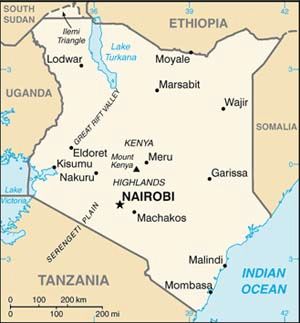Kenya
GHI Country Strategy
 The Global Health Initiative (GHI) Strategy for Kenya elevates efforts to strengthen health systems and improve the well-being of women and girls. Kenya’s GHI Strategy was based on Kenya’s National Health Sector Strategic Plan II, 2009–2012. The Government of Kenya has provided a comprehensive output- and performance-oriented plan that defines Kenyan aspirations and priorities for the health sector over the next 5 years. The latest National Health Sector Strategic Plan moves from a focus on the burden of disease to placing emphasis on promotion of individual and community health.
The Global Health Initiative (GHI) Strategy for Kenya elevates efforts to strengthen health systems and improve the well-being of women and girls. Kenya’s GHI Strategy was based on Kenya’s National Health Sector Strategic Plan II, 2009–2012. The Government of Kenya has provided a comprehensive output- and performance-oriented plan that defines Kenyan aspirations and priorities for the health sector over the next 5 years. The latest National Health Sector Strategic Plan moves from a focus on the burden of disease to placing emphasis on promotion of individual and community health.
The overarching GHI country goals for Kenya are to reduce unacceptably high rates of maternal, neonatal, and child mortality and morbidity and mortality from neglected tropical diseases (NTDs). To achieve these goals, the Kenya GHI Strategy has identified three focus areas for guiding U.S. investments in Kenya:
- Strengthening health systems
- Integrating services
- Increasing demand for and awareness of available services
The focus areas in Kenya’s GHI Strategy support the protection of women, infants, and children from preventable, treatable health conditions and the reduction of illness and death from NTDs. At the same time, the United States will continue to support Kenya in achieving critical results in HIV/AIDS, tuberculosis, and malaria.
- Download the Kenya GHI Strategy [PDF, 901KB]
GHI Principles in Action – Improve Metrics and Monitoring and Evaluation
The U.S. Government and the Kenya Medical Research Institute support a Health and Demographic Surveillance System that monitors health and demographic information of more than 200,000 people in Nyanza province in rural western Kenya. Data are collected from a variety of sources, including households, health facilities, and hospitals. Community workers conduct house-to-house interviews using personal digital assistants, which improve the quality of data collected; reduce data entry errors; and save paper, cost, and time. More than 14 million pieces of paper are saved each year. Surveillance data, which monitor childhood mortality among other conditions, are used to revise government policy and plan public health interventions.
Funding
For information on planned funding, please visit the Foreignassistance.gov country page.
Other U.S. Government Resources
